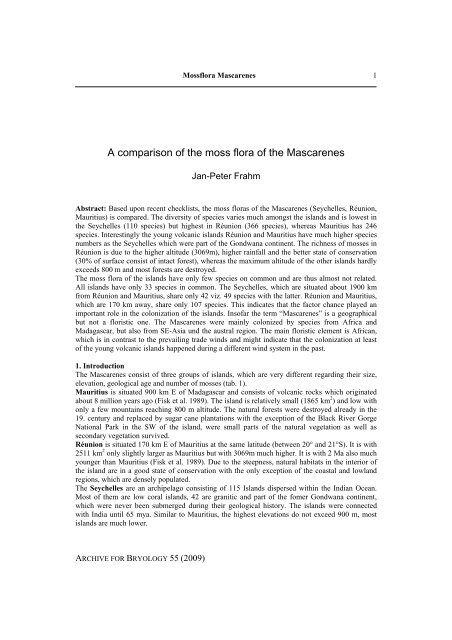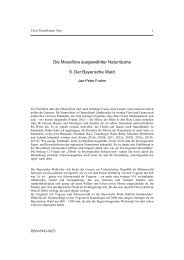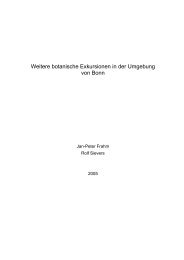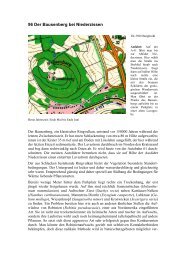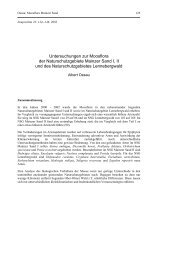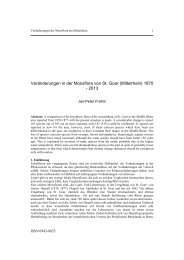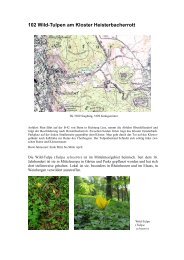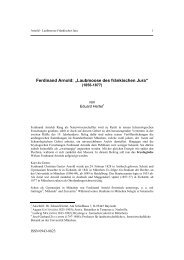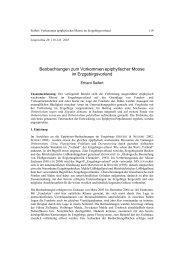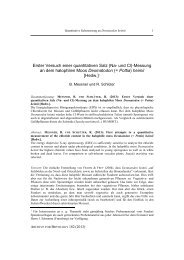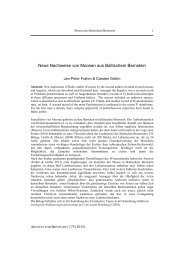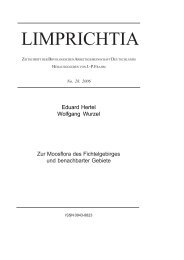Limprichtia xx: nn-nn, 2001 - Jan-Peter Frahm
Limprichtia xx: nn-nn, 2001 - Jan-Peter Frahm
Limprichtia xx: nn-nn, 2001 - Jan-Peter Frahm
Create successful ePaper yourself
Turn your PDF publications into a flip-book with our unique Google optimized e-Paper software.
Mossflora Mascarenes 1<br />
A comparison of the moss flora of the Mascarenes<br />
<strong>Jan</strong>-<strong>Peter</strong> <strong>Frahm</strong><br />
Abstract: Based upon recent checklists, the moss floras of the Mascarenes (Seychelles, Réunion,<br />
Mauritius) is compared. The diversity of species varies much amongst the islands and is lowest in<br />
the Seychelles (110 species) but highest in Réunion (366 species), whereas Mauritius has 246<br />
species. Interestingly the young volcanic islands Réunion and Mauritius have much higher species<br />
numbers as the Seychelles which were part of the Gondwana continent. The richness of mosses in<br />
Réunion is due to the higher altitude (3069m), higher rainfall and the better state of conservation<br />
(30% of surface consist of intact forest), whereas the maximum altitude of the other islands hardly<br />
exceeds 800 m and most forests are destroyed.<br />
The moss flora of the islands have only few species on common and are thus almost not related.<br />
All islands have only 33 species in common. The Seychelles, which are situated about 1900 km<br />
from Réunion and Mauritius, share only 42 viz. 49 species with the latter. Réunion and Mauritius,<br />
which are 170 km away, share only 107 species. This indicates that the factor chance played an<br />
important role in the colonization of the islands. Insofar the term “Mascarenes” is a geographical<br />
but not a floristic one. The Mascarenes were mainly colonized by species from Africa and<br />
Madagascar, but also from SE-Asia und the austral region. The main floristic element is African,<br />
which is in contrast to the prevailing trade winds and might indicate that the colonization at least<br />
of the young volcanic islands happened during a different wind system in the past.<br />
1. Introduction<br />
The Mascarenes consist of three groups of islands, which are very different regarding their size,<br />
elevation, geological age and number of mosses (tab. 1).<br />
Mauritius is situated 900 km E of Madagascar and consists of volcanic rocks which originated<br />
about 8 million years ago (Fisk et al. 1989). The island is relatively small (1865 km 2 ) and low with<br />
only a few mountains reaching 800 m altitude. The natural forests were destroyed already in the<br />
19. century and replaced by sugar cane plantations with the exception of the Black River Gorge<br />
National Park in the SW of the island, were small parts of the natural vegetation as well as<br />
secondary vegetation survived.<br />
Réunion is situated 170 km E of Mauritius at the same latitude (between 20° and 21°S). It is with<br />
2511 km 2 only slightly larger as Mauritius but with 3069m much higher. It is with 2 Ma also much<br />
younger than Mauritius (Fisk et al. 1989). Due to the steepness, natural habitats in the interior of<br />
the island are in a good state of conservation with the only exception of the coastal and lowland<br />
regions, which are densely populated.<br />
The Seychelles are an archipelago consisting of 115 Islands dispersed within the Indian Ocean.<br />
Most of them are low coral islands, 42 are granitic and part of the fomer Gondwana continent,<br />
which were never been submerged during their geological history. The islands were co<strong>nn</strong>ected<br />
with India until 65 mya. Similar to Mauritius, the highest elevations do not exceed 900 m, most<br />
islands are much lower.<br />
ARCHIVE FOR BRYOLOGY 55 (2009)
2<br />
<strong>Frahm</strong><br />
The question is now, to which extend are the moss floras of the islands are related? Are there any<br />
relation to age, size or elevation? Is there a “Mascarenian” element in the moss flora of the<br />
islands? From where took the colonization of the islands place?<br />
2. Methods<br />
The basis for this evaluation was<br />
- for Réunion the checklist by Ah-Peng & Bardat (2005), who listed 404 species incl. infraspecific<br />
taxa. Without varieties and with regard to corrections by <strong>Frahm</strong> (in prep.), the total number was<br />
reduced to 366.<br />
- for Mauritius the moss flora by <strong>Frahm</strong> et al. (2009), which consists of 238 species. An earlier<br />
bryophyte flora of Mauritius by Tixier (1996) was overlooked since it was published by the sugar<br />
cane company in Mauritius. This raised the number of species to 246.<br />
- for the Seychelles by <strong>Frahm</strong> & Ho (2009), which is based on O´Shea et al. (2006) and consists of<br />
110 species.<br />
The data for the Seychelles and Réunion reflect the present state of knowledge and are based on<br />
the original literature, however, the checklist for Réunion is based on a manuscript on disk entitled<br />
“Mosses from Africa 3 sensu Index Muscorum” compiled by Gillis Een. It includes many dubious<br />
records, perhaps errors in the Index Muscorum. This list has tentatively also been used for the<br />
compilation of the moss flora of Mauritius (<strong>Frahm</strong> et al. 2009), but records of many species could<br />
not be confirmed by the original literature, which were accordingly omitted. Thus the number of<br />
species of mosses in Réunion is surely too high.<br />
The data were entered in a spreadsheet and evaluated.<br />
.<br />
Tab. 1: Bryological and geographical data for the Mascarenes Islands.<br />
Mauritius Réunion Seychelles<br />
Size km 2 1865 2511 455<br />
Max. elevation m 828 3069 905<br />
Age (ma) 20 2 65-160<br />
Number of mosses 246 366 110<br />
endemic species 0 [72] 4<br />
The extreme discrepancy of the species numbers of mosses (110 – 246 – 366 species) ca<strong>nn</strong>ot be<br />
correlated with factors such as age, size or elevation of the islands. Although the highest island<br />
Réunion has the highest number of species, it is the youngest one and the Seychelles as the oldest<br />
islands have the lowermost species numbers. This raises questions such as<br />
- which species are found only on Mauritius, Réunion or the Seychelles?<br />
- which species are shared by Mauritius, Réunion or the Seychelles or part of the islands?<br />
- Can the Gondwanan element in the moss flora of the Seychelles be recognized? Are the<br />
mosses from Mauritius colonizer typical for long distance dispersal?<br />
- To which extend is the richness of the moss flora of Réunion based upon the high<br />
elevation?<br />
3. Results<br />
The results of the evaluation are summarized in tab. 2.<br />
Only 33 species are found in all islands, which is a remarkable low number and only 6,3 % of the<br />
total species.<br />
ISSN 0945-3466
Mossflora Mascarenes 3<br />
Fifty three species reported from the Seychelles (almost half of its moss flora) are found only on<br />
this archipelago and no other islands of the Mascarenes. Mauritius has 82 species (33% of the<br />
species) which are exclusively found on this island, Réunion 206 species (56,2%).<br />
One hundred seven species are found on Mauritius as well as Réunion, which is almost half of the<br />
moss flora of Mauritius but a quarter of the moss flora of Réunion. Taking into account the higher<br />
elevation of Mauritius and therefore the species which have no adequate habitat on Mauritius, we<br />
have an accordance of about 50% of mosses on both islands. In contrast, the Seychelles share only<br />
42 species with Réunion and 49 species with Mauritius, which is a remarkably low number. The<br />
low percentage of accordance of Réunion might be due to the higher elevation since only part of<br />
the species from Réunion can exist on the Seychelles. The percentage of species from the<br />
Seychelles in common with Réunion or Mauritius is, however, around 40%.<br />
Tab. 2: Relationships between the moss floras of the Mascarenes<br />
see appendix Percentage of total<br />
Species only on the Seychelles 53 5 48,1<br />
Species only on Mauritius 82 7 33<br />
Species only on Réunion 206 6 39,7<br />
Species common on all islands 33 1 6,3<br />
Species on the Seychelles and 49 4 19,9 (Mauritius)<br />
Mauritius<br />
44,5 (Seychelles)<br />
Species on the Seychelles and 42 3 11,4 (Réunion)<br />
Réunion<br />
38,1 (Seychelles)<br />
Species on Réunion and Mauritius 145 2 58,9 (Mauritius)<br />
39,6 (Réunion)<br />
Species in total 519<br />
Species on Mauritius 246<br />
Species on Réunion 366<br />
Species on the Seychelles 110<br />
The poor moss flora of the Seychelles is striking: there is no one species of Leucobryum,<br />
Polytrichum is present with one species (but 4 in Réunion), Pogonatum is lacking (but 7 species in<br />
Réunion), Schlotheimia is lacking (but 11 in Réunion), Sphagnum is lacking (even in Mauritius<br />
are 5 species). The Seychelles are not more undercollected than the other islands, since species of<br />
Pogonatum or Polytrichum would have been collected. The lack of species on the Seychelles<br />
ca<strong>nn</strong>ot be explained by the geology (granite in contrast to volcanic soil on the other islands), nor<br />
the humidity (the highest parts are even more humid than the according regions on Mauritius) or<br />
the restriction of wet forests to small areas (similar to Mauritius). All islands are under the<br />
influence of the southeastern trade winds and have almost the same chances to be colonized by<br />
moss spores. It almost seems as if there has been an extinction event on the Seychelles. Or is this<br />
an effect of the small size?<br />
The high number (55) percentage of species on the Seychelles (appendix 5), which area confined<br />
to this archipelago, shows that it probably has conserved part of the Gondwanan flora. Its high age<br />
is reflected by a comparably “high” rate of endemism.<br />
ARCHIVE FOR BRYOLOGY 55 (2009)
4<br />
<strong>Frahm</strong><br />
Fig. 1: Bryofloristic relationships between the Mascarenes Island based on mosses. S =<br />
Seychelles, M = Mauritius, R = Réunion. Numbers = species numbers, in brackets = species only<br />
found on this island.<br />
ISSN 0945-3466
4. Phytogeographical elements<br />
Mossflora Mascarenes 5<br />
The Mascarenes are located approx. 3300 km (Seychelles) or 5000 km (Réunion, Mauritius)<br />
away from Indonesia but only 800 km (Réunion) viz. 980 km away from Madagascar. This should<br />
cause a stronger floristic affinity to Africa. On the other hand, the prevailing wind system is the SE<br />
trade wind.<br />
The presence of SE-asiatic floristic elements on the Mascarenes can be explained (except for<br />
introduction by man) mainly by long distance dispersal and demonstrate the enormous success of<br />
spore dispersal. The spores are released in the source range and dispersed over the Indian Ocean,<br />
in which the islands cover only an extremely small part. The size of the Indian Ocean between<br />
Indonesia and the Mascarenes is about 14 million km 2 , whereas the area of the islands is about<br />
6000 km 2 . So the chance for a spore to meet an island is 1:2333. The chance is even much lower if<br />
one considers that the species does not occur everywhere in the source range and if it lands on an<br />
island, must meet an appropriate habitat.<br />
It is difficult to set up a list of phytogeographical elements of all species due to the lack of<br />
information. However, a genus can be used for a case study. Campylopus is one of the largest<br />
moss genera and almost worldwide distributed. It is present on the Mascarenes with 25 species and<br />
therefore quite representative. These 25 species belong to the following phytogeographical<br />
elements:<br />
1. African: arctocarpus, arcuatus, aureonitens, cambouei, crateris, flaccidus, flavicoma,<br />
hildebrandtii, julaceus, nanophyllus, praetermissus, pseudobicolor, robillardei,<br />
smaragdinus, trachyblepharum.<br />
2. neotropical and African (tropical montane-subalpine): jamesonii, fragilis, flexuosus,<br />
pilifer, nivalis.<br />
3. Austral: introflexus, pyriformis.<br />
4. SE-Asian: schmidii.<br />
5. Endemic: fuscolutescens.<br />
6. Gondwanan: thwaitesii.<br />
Fifteen of twenty-five species belong to the African element, which seems to be not surprising<br />
since this is the nearest continent. However, Africa is situated against the prevailing wind system!<br />
Four species are endemic on the Seychelles but no one is known from Mauritius (tab. 1) , which<br />
reflects the younger age. In contrast, seventy-two species were indicated as endemic for Réunion<br />
(17%) by Ah-Peng & Bardat (2005), a number which is certainly wrong because many of the<br />
species marked as endemic are more widespread. Generally the indication of rates of endemism in<br />
bryophytes are dubious because they will not last long but tend to decline with increasing<br />
taxonomic and floristic research.<br />
5. Discussion<br />
The low number of species common in all islands is a strange fact, especially under consideration<br />
that the climatic conditions on all islands are comparable. It corroborates somewhat the hypothesis<br />
that mosses are widespread, have wide ranges and are easily dispersed.<br />
A similar analysis has been performed with the islands of the Azores (<strong>Frahm</strong> ). It resulted in the<br />
fact that neither distance, altitude, size or age of the islands correlate with the species numbers und<br />
led to the conclusion that the distribution pattern of bryophytes is primarily based in chance.<br />
Chance (or unknown reasons) seems also to determine the moss flora of the Mascarenes.<br />
ARCHIVE FOR BRYOLOGY 55 (2009)
6<br />
<strong>Frahm</strong><br />
Acknowledgements<br />
I wish to thank Brian O´Shea and Tamas Pócs for providing Tixier´s bryoflora of Mauritius.<br />
References<br />
Ah-Peng, C., Bardat, J. 2005. Ckeck list of the bryophytes of Réunion Island. Tropical Bryology<br />
26: 89-118.<br />
Fisk, M.R., Duncan, R.A., Baxter, A.N., Greenough, J.D. Hargraves, R.B., Tatsumi, Y. 1989.<br />
Réunion hot spot magma chemistry over the past 65 m.y.: Results from Leg 115 of ther<br />
Ocean Drilling Program. Geology 17: 934-937.<br />
<strong>Frahm</strong>, J.-P. 2005. An evaluation of the bryoflora of the Azores. Tropical Bryology 26: 57-80.<br />
<strong>Frahm</strong>, J.-P. in prep. Additions and corrections to the moss flora of Réunion. Archive for<br />
Bryology.<br />
<strong>Frahm</strong>, J.-P., Ho, B.C. 2009. A new contribution to the moss flora of the I<strong>nn</strong>er Seychelles. Archiv<br />
for Bryology 38: 1-16.<br />
<strong>Frahm</strong>, J.-P., O´Shea, B.J., Ho, B.C. 2009. The Moss Flora of Mauritius. Archive for Bryology 51:<br />
1-26.<br />
O´Shea, B.J. 2006. Checklist of the mosses of Subsaharan Africa (version 5). Tropical Bryology<br />
Research report 6: 1-252.<br />
ISSN 0945-3466
Appendix<br />
1. Species occuring on all islands<br />
(33)<br />
Acroporium megasporum<br />
Barbula indica<br />
Aerobryopsis capensis<br />
Barbula indica<br />
Brachymenium exile<br />
Bryum apiculatum (nitens)<br />
Calymperes hispidum<br />
Calymperes palisotii<br />
Calymperes taitense<br />
Campylopus arctocarpus<br />
Campylopus arcuatus<br />
Campylopus flexuosus<br />
Campylopus julaceus<br />
Campylopus robillardei<br />
Distichophyllum mascarenicum<br />
Ectropothecium regulare<br />
Fissidens crispulus<br />
Hyophila involuta<br />
Leucoloma longifolium<br />
Leucoloma seychellense<br />
Leucoloma sinuosulum<br />
Leucophanes angustifolium<br />
Macrohymenium acidodon<br />
Macromitrium pallidum<br />
Octoblepharum albidum<br />
Papillaria africana<br />
Philonotis hastata<br />
Philonotis mauritiana<br />
Polytrichum subpilosum<br />
Porotrichum elongatum<br />
Pyrrhobryum spiniforme<br />
Radulina borbonica<br />
Serpotorella cyrtophylla<br />
Syrrhopodon involutus<br />
Trachyphyllum inflexum<br />
2. Species occuring on Réunion and<br />
Mauritius (145)<br />
Acroporium megasporum<br />
Aerobryopsis capensis<br />
Anoectangium aestivum<br />
Anomodon pseudotristis<br />
Atrichum androgynum<br />
Barbula indica<br />
Bartramia gigantea<br />
ARCHIVE FOR BRYOLOGY 55 (2009)<br />
Mossflora Mascarenes<br />
Brachymenium eurychelium<br />
Brachymenium exile<br />
Brachymenium leptophyllum<br />
Brachythecium borgenii<br />
Breutelia magdalenae<br />
Bryum apiculatum (nitens)<br />
Bryum argenteum<br />
Bryum aubertii<br />
Bryum billardierei<br />
Bryum coronatum<br />
Callicostella fissidentella<br />
Callicostella salaziae<br />
Calymperes hispidum<br />
Calymperes palisotii<br />
Calymperes taitense<br />
Calyptrotheca asplenioides<br />
Campylopus arctocarpus<br />
Campylopus arcuatus<br />
Campylopus aureonitens<br />
Campylopus flexuosus<br />
Campylopus hildebrandtii<br />
Campylopus julaceus<br />
Campylopus pilifer<br />
Campylopus praetermissus<br />
Campylopus robillardei<br />
Campylopus thwaitesii<br />
Campylopus trachyblepharum<br />
Cardotiella appendiculata<br />
Cardotiella subappendiculata<br />
Catagonium nitens<br />
Ceratodon purpureus<br />
Chaetomitrium borbonicum<br />
Cyclodictyon vesiculosum<br />
Distichophyllum mascarenicum<br />
Ditrichum difficile<br />
Ectropothecium regulare<br />
Ectroprothecium valentinii<br />
Entodon dregeanus<br />
Entosthodon borbonicus<br />
Fissidens crispulus<br />
Fissidens darntyi<br />
Fissidens ovatus<br />
Fissidens palmifolius<br />
Fissidens plumosus<br />
Floribundaria floribunda<br />
Floribundaria vaginans<br />
Funaria hygrometrica<br />
Hildebrantiella phleoides<br />
Holomitrium borbonicum<br />
7
2<br />
Holomitrium cyclindraceum<br />
Homaliodendron exiguum<br />
Hymenostylium scaturiginosum<br />
Hyophila involuta<br />
Hypopterygium tamarisci<br />
Isopterygium intortum<br />
Jaegerina solitaria<br />
Leiomitrium plicatum<br />
Leptodon fuciformis<br />
Leucobryum boryanum<br />
Leucobryum isleanum<br />
Leucobryum mayottense<br />
Leucoloma bifidum<br />
Leucoloma candidulum<br />
Leucoloma cinclidotioides<br />
Leucoloma fuscifolium<br />
Leucoloma lepervancheri<br />
Leucoloma longifolium<br />
Leucoloma persecundum<br />
Leucoloma rutenbergii<br />
Leucoloma seychellense<br />
Leucoloma sinuosulum<br />
Leucophanes angustifolium<br />
Leucophanes hildebrandtii<br />
Leucophanes rodriguezii<br />
Lopidium struthiopteris<br />
Macrohymenium acidodon<br />
Macromitrium fimbriatum<br />
Macromitrium mauritianum<br />
Macromitrium pallidum<br />
Macromitrium voeltzkowii<br />
Meiothecium madagascariense<br />
Mittenothamnium madagassum<br />
Mittenothamnium reptans<br />
Neckeropsis lepineana<br />
Octoblepharum albidum<br />
Orthostichidium pentasticha<br />
Orthostichopsis longinervis<br />
Papillaria africana<br />
Philonotis gracilescens<br />
Philonotis hastata<br />
Philonotis mauritiana<br />
Pi<strong>nn</strong>atella minuta<br />
Pogonatum belangeri<br />
Pogonatum convolutum<br />
Pogonatum gracilifolium<br />
Polytrichum commune<br />
Polytrichum formosum<br />
Polytrichum subpilosum<br />
Porotrichum elongatum<br />
Porotrichum madagassum<br />
<strong>Frahm</strong><br />
Porotrichum stipitatum<br />
Porotrichum usagarum<br />
Prionodon ciliatus<br />
Pterogonium gracile<br />
Pyrrhobryum spiniforme<br />
Racomitrium lanuginosum<br />
Racopilum africanum<br />
Racopilum ayresii<br />
Racopilum mauritianum<br />
Racopilum tomentosum<br />
Radulina borbonica<br />
Rhodobryum commersonii<br />
Rhynchostegium distans<br />
Rutenbergia prionodon<br />
Schlotheimia angulosa<br />
Schlotheimia badiella<br />
Schlotheimia fornicata<br />
Schlotheimia robillardi<br />
Sematophyllum crassiusculum<br />
Sematophyllum schimperi<br />
Sematophyllum subpi<strong>nn</strong>atum<br />
Serpotorella cyrtophylla<br />
Sphagnum perichaetiale<br />
Sphagnum rutenbergii<br />
Sphagnum truncatum<br />
Sphagnum tumidulum<br />
Sphagnum violascens<br />
Syrrhopodon involutus<br />
Syrrhopodon mauritianus<br />
Taxithelium pseudo-amoenum<br />
Tortella humilis<br />
Trachyphyllum inflexum<br />
Trematodon subambiguus<br />
Trichostomum brachydontium<br />
Trichostomum crispulum<br />
Trichostomum tenuirostre<br />
Ulota fulva<br />
Warburgiella leptorrhyncha<br />
Weissia ayresii<br />
3. Species occuring on the<br />
Seychelles and Réunion (42)<br />
Acroporium megasporum<br />
Aerobryopsis capensis<br />
Barbula indica<br />
Brachymenium exile<br />
Bryum apiculatum (nitens)<br />
Calymperes hispidum<br />
Calymperes palisotii<br />
Calymperes taitense<br />
Campylopus arctocarpus<br />
ISSN 0945-3466
Campylopus arcuatus<br />
Campylopus flexuosus<br />
Campylopus julaceus<br />
Campylopus nanophyllus<br />
Campylopus robillardei<br />
Distichophyllum mascarenicum<br />
Ectropothecium regulare<br />
Fissidens crispulus<br />
Fissidens pellucidus<br />
Fissidens sciophyllus<br />
Garckea flexuosa<br />
Hyophila involuta<br />
Leucoloma longifolium<br />
Leucoloma seychellense<br />
Leucoloma sinuosulum<br />
Leucomium strumosum<br />
Leucophanes angustifolium<br />
Macrohymenium acidodon<br />
Macromitrium pallidum<br />
Octoblepharum albidum<br />
Papillaria africana<br />
Philonotis hastata<br />
Philonotis mauritiana<br />
Polytrichum subpilosum<br />
Porotrichum elongatum<br />
Pyrrhobryum spiniforme<br />
Radulina borbonica<br />
Serpotorella cyrtophylla<br />
Syrrhopodon armatus<br />
Syrrhopodon involutus<br />
Syrrhopodon mahensis<br />
Syrrhopodon prolifer<br />
Trachyphyllum inflexum<br />
4. Species occuring on the<br />
Seychelles and Mauritius (49)<br />
Acroporium megasporum<br />
Aerobryopsis capensis<br />
Aerobryopsis longissima<br />
Barbula indica<br />
Brachymenium exile<br />
Bryum apiculatum (nitens)<br />
Bryum leptospeiron<br />
Callicostella brevipes<br />
Callicostella seychellensis<br />
Calymperes graeffeanum<br />
Calymperes hispidum<br />
Calymperes palisotii<br />
Calymperes taitense<br />
ARCHIVE FOR BRYOLOGY 55 (2009)<br />
Mossflora Mascarenes 3<br />
Calymperes tenerum<br />
Campylopus arctocarpus<br />
Campylopus arcuatus<br />
Campylopus flexuosus<br />
Campylopus julaceus<br />
Campylopus robillardei<br />
Cyclodictyon vallis-gratiae<br />
Distichophyllum mascarenicum<br />
Ectropothecium regulare<br />
Fissidens crispulus<br />
Fissidens serratus<br />
Hyophila involuta<br />
Isopterygium argyroleucum<br />
Leucoloma delicatulum<br />
Leucoloma dichelymoides<br />
Leucoloma isleanum<br />
Leucoloma longifolium<br />
Leucoloma seychellense<br />
Leucoloma sinuosulum<br />
Leucophanes angustifolium<br />
Macrohymenium acidodon<br />
Macromitrium pallidum<br />
Octoblepharum albidum<br />
Papillaria africana<br />
Philonotis hastata<br />
Philonotis mauritiana<br />
Polytrichum subpilosum<br />
Porotrichum elongatum<br />
Pyrrhobryum spiniforme<br />
Radulina borbonica<br />
Serpotorella cyrtophylla<br />
Syrrhopodon hispidocostatus<br />
Syrrhopodon involutus<br />
Syrrhopodon revolutus<br />
Trachyphyllum inflexum<br />
Vesicularia albo-viridis<br />
5. Species which only occur on the<br />
Seychelles (53)<br />
Acanthorrhynchium papillatum<br />
Acroporium diminutum<br />
Acroporium lamprophyllum<br />
Brachymenium dicranoides<br />
Bryum alpinum<br />
Callicostella africana<br />
Calymperes afzelii<br />
Calymperes couguiense<br />
Calymperes erosum<br />
Calymperes motleyi
4<br />
Calymperes norkettii<br />
Calymperes pallidum<br />
Campylopus flacidus<br />
Clastobryophilum bogoricum<br />
Cyclodictyon hildebrandtii<br />
Dicranella acroclada<br />
Dicranella polii<br />
Ectropothecium brachycladulum<br />
Ectropothecium chenagonii<br />
Ectropothecium perrottii<br />
Ectropothecium seychellarum<br />
Ectropothecium squarrifolium<br />
Fissidens bristatosus<br />
Fissidens ceylonesis<br />
Fissidens flaccidus<br />
Fissidens jeffreyi<br />
Fissidens marthae<br />
Fissidens minutus<br />
Fissidens reflexus<br />
Fissidens seychellensis<br />
Fissidens zollingeri<br />
Himantocladium cyclophyllum<br />
Isopterygium gracile<br />
Isopterygium subleptoblastum<br />
Leucoloma strumosum<br />
Leucophanes glaucum<br />
Leucophanes octoblepharioides<br />
Leucophanes seychellarum<br />
Luisierella barbula<br />
Macromitrium sclerodictyon<br />
Macromitrium subpungens<br />
Mitthyridium fasciculatum<br />
Neckeropsis boiviniana<br />
Papilliopsis mahensis<br />
Pelekium gratum<br />
Pi<strong>nn</strong>atella mucronata<br />
Syrrhopodon albidus<br />
Syrrhopodon croceus<br />
Taxithelium instratum<br />
Taxithelium planulum<br />
Trichosteleum debettei<br />
Trichosteleum stictum<br />
Vesicularia crassiramea<br />
6. Species which only occur on<br />
Réunion (206)<br />
Aerobrydium subpiligerum<br />
Amphidium tortuosum<br />
<strong>Frahm</strong><br />
Anacolia laevisphaera<br />
Andreaea borbonica<br />
Andreaea tsaratananae<br />
Anisothecium cardotti<br />
Anoectangium mafatense<br />
Anoectangium rhaphidostegium<br />
Anomobryum laceratum<br />
Anomodon tristis<br />
Aongstroemia filiformis<br />
Aongstroemia julacea<br />
Astomum borbonicum<br />
Atractylocarpus madagascariensis<br />
Barbula unguiculata<br />
Bartramia ithyphylla<br />
Bartramia longifolia<br />
Blindia acuta<br />
Blindia magellanica<br />
Brachymenium gemmiferum<br />
Brachymenium pulchrum<br />
Brachythecium chauvetii<br />
Brachythecium decurrens<br />
Brachythecium plumosum<br />
Brachythecium valentinii<br />
Breutelia borbonica<br />
Breutelia gnaphalea<br />
Breutelia perrieri<br />
Breutelia stenodictyon<br />
Breutelia stuhlma<strong>nn</strong>ii<br />
Bryoerythrophyllum campylocarpum<br />
Bryum cadetii<br />
Bryum celluare<br />
Bryum pseudotriquetrum<br />
Calyptothecium acutifolium<br />
Campylopus crateris<br />
Campylopus fragilis<br />
Campylopus introflexus<br />
Campylopus jamesonii<br />
Campylopus nivalis<br />
Campylopus pyriformis<br />
Campylopus schmidii<br />
Campylopus smaragdinus<br />
Cyclodictyon albicans<br />
Cyclodictyon borbonicum<br />
Cyclodictyon brevifolium<br />
Cyclodictyon perrottetii<br />
Daltonia angustifolia<br />
Daltonia latimarginata<br />
Daltonia onraedtii<br />
Dicranella cratericola<br />
Dicranella flavipes<br />
Dicranella subsubulata<br />
ISSN 0945-3466
Dicranoloma billardierei<br />
Dicranoloma borbonicum<br />
Didymodon maschalogena<br />
Ditrichum punctulatum<br />
Ectroprothecium occulum<br />
Ectroprothecium viridulum<br />
Entodon geminidens<br />
Entodon macropodu<br />
Entosthodon lepervanchei<br />
Eurhynchium acicladium<br />
Eustichia longirostris<br />
Felipponea assimilis<br />
Fissidens asplenioides<br />
Fissidens brevifrons<br />
Fissidens ellipticus<br />
Fissidens intramarginatus<br />
Fissidens planifrons<br />
Fissidens pseudoplumosus<br />
Grimmia eongata<br />
Grimmia laevigata<br />
Grimmia longirostris<br />
Gymnostomiella vernicosa<br />
Hedwigidum integrifolium<br />
Hildebrandtiella rotundifolia<br />
Hookeria splachnifolia<br />
Hylocomnium brevirostre<br />
Hymenostylium recurvirostrum<br />
Hypnum bicolor<br />
Hypnum boryanum<br />
Hypnum cupressiforme<br />
Hypnum jutlandicum<br />
Hypnum macrogynum<br />
Hypnum radiatum<br />
Isopterygium citrinellum<br />
Isopterygium molle<br />
Isopterygium radicans<br />
Leiomela bartramioides<br />
Lepidopilidium caespitosa<br />
Lepidopilidium flexuosum<br />
Lepidopilidium hirsutum<br />
Lepidopilidium isleanum<br />
Leptodontium flexifolium<br />
Leptodontium longicaule<br />
Leptodontium pungens<br />
Leptodontium viticulosoides<br />
Leptophascum leptophyllum<br />
Leptotrichella lutaria<br />
Leucobryum javense<br />
Leucobryum juniperoideum<br />
Leucoloma boivinianum<br />
Leucoloma capillifolium<br />
ARCHIVE FOR BRYOLOGY 55 (2009)<br />
Mossflora Mascarenes 5<br />
Leucoloma cirrosulum<br />
Leucoloma mafatense<br />
Leucoloma membranaceum<br />
Leucoloma onraedtii<br />
Leucoloma sanctae-mariae<br />
Leucoloma subcespitulans<br />
Macrocoma tenuis<br />
Macromitrium belangeri<br />
Macromitrium fasciculare<br />
Macromitrium gimalacii<br />
Macromitrium rufescens<br />
Macromitrium scleropodium<br />
Macromitrium serpens<br />
Mielichhoferia borbonica<br />
Mittenothamnium limosum<br />
Mittenothamnium microthmanioides<br />
Neckera valentiana<br />
Orthodontium loreifolium<br />
Orthostichidium involutifolium<br />
Orthostichopsis subimbricata<br />
Orthostichopsis sublivens<br />
Palamocladium leskeoides<br />
Pelekium versicolor<br />
Philonotis perigonialis<br />
Philonotis scabrifolia<br />
Philonotis submarchica<br />
Phyllodon perplanicaulis<br />
Phyllodon truncatulus<br />
Phyllogonium viscosum<br />
Physcomitrium spathulatum<br />
Pilotrichella isleana<br />
Pilotrichella mascarenica<br />
Pilotrichella phleoides<br />
Plagiomnium rhynchphorum<br />
Plagiothecium nitens<br />
Pogonatum perichaetiale<br />
Pogonatum urnigerum<br />
Pogonatum usambaricum<br />
Polytrichum piliferum<br />
Porothamnium variifolioides<br />
Pseudephemerum nitidium<br />
Pseudopohlia microstoma<br />
Pseudoscleropodium purum<br />
Pseudosymblepharis bombayensis<br />
Pseudosymblepharis circi<strong>nn</strong>atula<br />
Ptychomitrium subcrispatum<br />
Racomitrium membranaceum<br />
Racomitrium subsecundum<br />
Racopilum capense<br />
Racopilum schmidii<br />
Rhacocarpus purpurascens
6<br />
Rhaphydorrhynchium crispans<br />
Rhaphydorrhynchium rubricaule<br />
Rhodobryum giganteum<br />
Rhynchostegiella tenelliformis<br />
Rhynchostegium comorae<br />
Rhyncostegium pseudodistans<br />
Rutenbergia borbonica<br />
Schistidium apocarpum<br />
Schlotheimia brachyphylla<br />
Schlotheimia illecebra<br />
Schlotheimia malacophylla<br />
Schlotheimia microcarpa<br />
Schlotheimia richardii<br />
Schlotheimia squarrosa<br />
Schlotheimia subfornicata<br />
Schwetschkea grateloupii<br />
Sematophyllum sinuosulum<br />
Serpotorella chenagonii<br />
Sphagnum bourbonense<br />
Sphagnum capense<br />
Sphagnum capillifolium<br />
Sphagnum ceylonicum<br />
Sphagnum condensatum<br />
Sphagnum davidii<br />
Sphagnum ericetorum<br />
Sphagnum strictum<br />
Squamidium brasiliense<br />
Stereophyllum radiculosum<br />
Symphyodon pygmaeus<br />
Syrrhopodon asper<br />
Syrrhopodon gardneri<br />
Syrrhopodon gaudichaudii<br />
Syrrhopodon parasiticus<br />
Syrrhopodon rodriguezii<br />
Tayloria isleana<br />
Tayloria orthodonta<br />
Thuidium aculeoserratum<br />
Thuidium assimile<br />
Thuidium tamariscinum<br />
Tortella vernicosa<br />
Trachypodopsis serrulata<br />
Trachypus bicolor<br />
Trematodon borbonicus<br />
Trematodon paradoxus<br />
Trichosteleum adhaerens<br />
Trichosteleum constrictum<br />
Trichosteleum debettei<br />
Trichosteleum pervilleanum<br />
Trichostomum cardotii<br />
<strong>Frahm</strong><br />
7. Species which only occur on<br />
Mauritius (82)<br />
Aerobryopsis cirrifolia<br />
Archidium ohioense<br />
Barbella capillicaulis<br />
Barbula inclinans<br />
Brachymenium acuminatum<br />
Brachymenium nepalense<br />
Brachythecium implicatum<br />
Bryoxiphium norvegicum<br />
Bryum erythrocaulon<br />
Bryum huillense<br />
Bryum muehlenbeckii<br />
Callicostella erosotruncata<br />
Callicostella lacerans<br />
Callicostella parvocellulata<br />
Calliegonella cuspidata<br />
Calymperes dozyanum<br />
Calymperes nossi-combae<br />
Campylopus cambouei<br />
Campylopus flavicoma<br />
Campylopus fusco-lutescens<br />
Campylopus pseudobicolor<br />
Cyclodictyon aubertii<br />
Ectropothecium intertextum<br />
Ectropothecium mauritianum<br />
Ectropothecium nishimurii<br />
Ectropothecium paillotii<br />
Entodon motelayi<br />
Entosthodon mauritianus<br />
Fissidens subexasperatus<br />
Fissidens subplanifrons<br />
Glossadelphus scutellifolius<br />
Groutiella laxotorquata<br />
Groutiella tomentosa<br />
Gymnostomum calcareum<br />
Helicodontium lanceolatum<br />
Holomitrium lepervanchei<br />
Homaliodendron flabellatum<br />
Homaliodendron piniforme<br />
Hydrogonium consanguineum<br />
Hypnum gracilirameum<br />
Jaegerina formosa<br />
Jaegerina retrosquarrosa<br />
Jaegerina robillardii<br />
Lepidopillidium subrevolutum<br />
Lepidopilum lastii<br />
Leskea mauritiana<br />
Leucobryum comorense<br />
ISSN 0945-3466
Leucobryum perrotii<br />
Leucoloma amblyacron<br />
Leucoloma grimmioides<br />
Leucoloma pallidulum<br />
Leucophanes octoblepharioides<br />
Leucophanes renauldii<br />
Macromitrium funicaule<br />
Mesonodon flavescens<br />
Mittenothamnium serratum<br />
Orthostichella longinervis<br />
Orthostichella rigida<br />
Oxystegus rhodesiae<br />
Papillaria acinacifolia<br />
Papillaria renauldii<br />
Pogonatum capense<br />
Rhizofabronia persoonii<br />
Schlotheimia ferruginosa<br />
Schlotheimia microphylla<br />
Scorpiurium circinatum<br />
Sematophyllum aneuron<br />
Sematophyllum corticola<br />
Sematophyllum longinerve<br />
Stereophyllum limnobioides<br />
Syrrhopodon apertifolius<br />
Syrrhopodon graminifolius<br />
Taxithelium lindbergii<br />
Thamniopsis pappeana<br />
Thuidium pseudoinvolvens<br />
Tortella caespitosa<br />
Tortula rufa<br />
Trichosteleum borbonicum<br />
Trichosteleum microdontum<br />
Trichosteleum perottii<br />
Vesicularia ayresii<br />
Vesicularia bescherellei<br />
ARCHIVE FOR BRYOLOGY 55 (2009)<br />
Mossflora Mascarenes<br />
7


